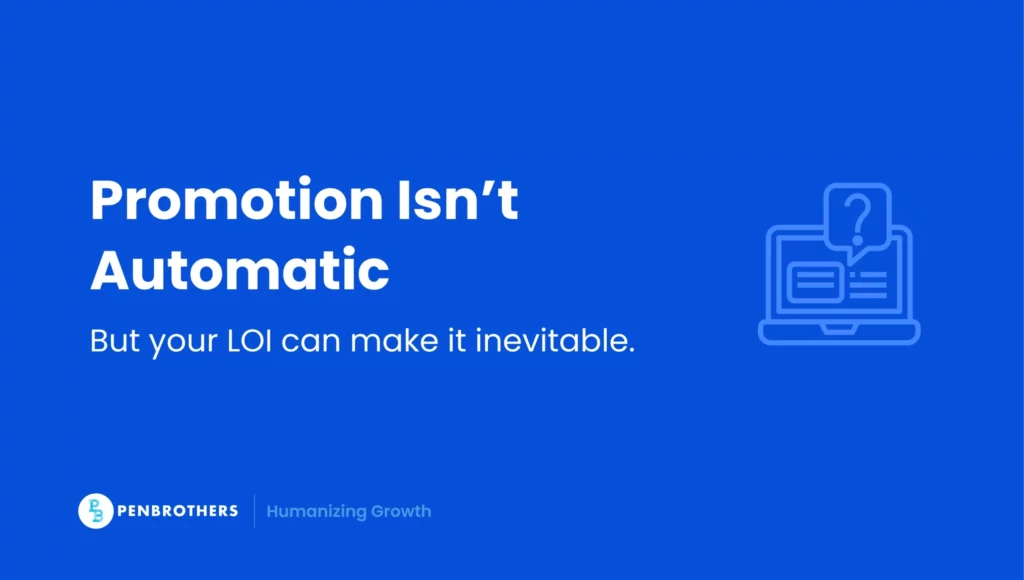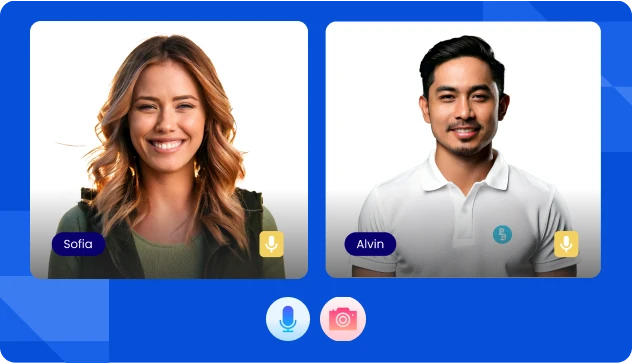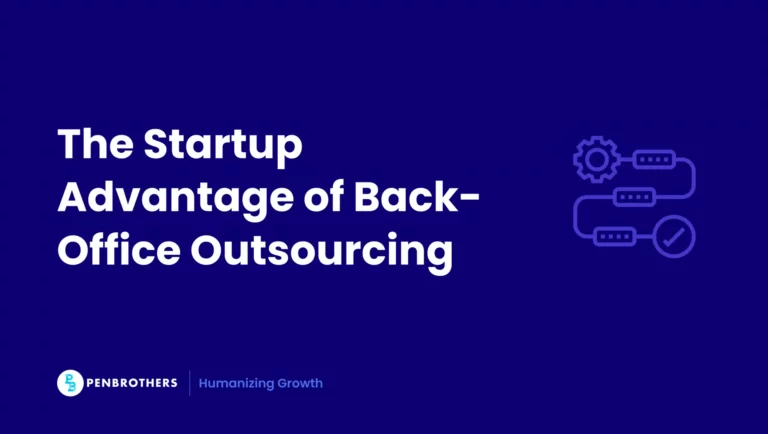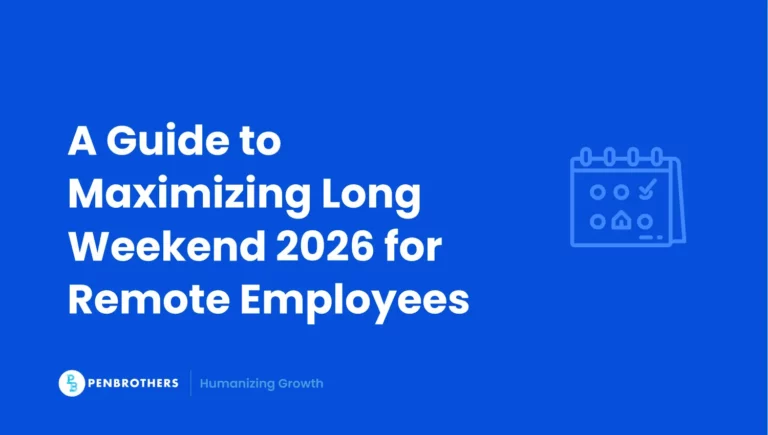It’s a common feeling. You’ve put in the work, you’ve hit your goals, and you’re ready for the next step. But when you work remotely, how do you make that known without a casual chat at the water cooler? Think of your promotion letter as a strategic move to define your career story and formally champion your advancement. We’ll go beyond a simple template and provide you with the strategic insights and actionable steps needed on how to write a letter of intent for a job promotion that gets noticed and has better chances of getting a yes.
Key Takeaways
- A Strategic Tool for Remote Employees: A letter of intent for promotion is a critical, formal tool for a remote employee. It is not just an application, but a strategic document that ensures their readiness for advancement is formally visible to management, which is essential in an environment without in-person interactions.
- Timing Aligned with Business Cycles is Key: The letter should be timed strategically, ideally sent a few weeks before the company’s official performance review cycle. This gives your manager the necessary time to review your case and become your advocate during the formal promotion and budget planning process.
- Your Manager is Your Advocate, Not Your Audience: The purpose of the letter is to arm your manager with a “toolkit” they can use to make a compelling case for you in promotion meetings you are not in. It must be a concise, data-driven narrative memo, not just a list of your past duties.
- Focus on Future Value, Not Just Past Achievements: A strong promotion case is an investment in your future, not a reward for your past. Your letter must go beyond listing accomplishments and provide a data-driven forecast of your future value, demonstrating how you are already operating at the next level and how your promotion will help solve a specific, high-level business problem.
What is a Statement of Intent for Promotion?
A statement of intent for promotion is a formal document that signals your ambition and readiness to advance. It is not the full application, but rather the strategic opening to the conversation.
Think of it as the executive summary for your promotion case. Its primary purpose is to:
- Formally notify your manager of your career goals.
- Initiate the official review process.
- Present a high-level case for your advancement, which will be supported by your full promotion packet.
For a remote employee, this letter is a critical tool to gain formal visibility and move from “under consideration” to “in the pipeline.”
How to Properly Write a Letter of Intent?
Writing a promotion letter requires more than just a template. It demands intentional timing and a remote-first approach to evidence. This is your chance to showcase your impact when a physical presence isn’t an option.
The Strategic Timing of Your LOI
Timing is everything. Your letter is most effective when it aligns with the company’s internal promotion cycle. Send it a few weeks before annual or mid-year reviews. This gives your manager time to build your case and advocate for you.
- Decision Tree: An effective LOI should follow this path: LOI → Manager Sync → Internal Posting → Panel/Packet → Comp Review.
- Red Flags: Don’t send an LOI during promotion freezes or if your company has specific tenure requirements. Be mindful of RTO (Return to Office) policies that may tie promotion eligibility to in-office days.
The Remote-First Promotion Packet
For remote employees, impact is measured by outcomes, not visibility. This is very crucial as some companies are keener to promote those who report to the office more. You must be proactive and build a comprehensive evidence bundle to combat proximity bias.
- Proof of Impact: For your letter to be effective, every claim should be supported by evidence. Attach a data-driven portfolio that includes links to OKR dashboards, async decision logs, and recorded design reviews.
- Stakeholder Strategy: Cultivate sponsors remotely. A monthly 20-minute update call or a quarterly portfolio recap can be crucial.
- Who to CC: Your letter and a narrative memo should go to your line manager first. Only CC your skip-level manager or HR Business Partner once your manager is aligned with your intent.
A Playbook for Different Scenarios
No two promotions are the same. Here’s how to adapt your language for common remote scenarios:
- “You’re already acting in the role”: “For the last [X] months, I’ve been successfully performing the duties of a [Target Role]. My achievements include [Specific Outcome], demonstrating my readiness and commitment to this position.”
- “No open req yet”: “I am proactively seeking to advance my career to [Target Role]. While there is no open requisition, I believe my recent contributions to [Project Name] and my development in [Skill] align with the needs of the team for the next phase of growth.”
How Do You Write a Reason for Promotion?
Your reason for promotion must be more than an aspiration. It needs to be a compelling, evidence-based argument. This is where you connect your past achievements to your future value.
1. The ‘Narrative Memo’ for Your Manager
Your manager is your primary advocate, and your letter is their toolkit. A promotion decision is often made in a room you’re not in, where managers must make a strong case for their team members. Your reason for promotion should be a concise narrative memo, packed with all the talking points your manager needs.
- Don’t just state achievements; give them the story. Instead of writing, “I improved a process,” provide the full narrative: “I saw a gap in our team’s workflow that was costing us 15 hours a month. I prototyped and implemented a new process in Q3, and now every team member uses it, saving us over 60 hours per quarter. This is the kind of proactive, strategic thinking I will bring to the [New Role].”
- Provide a “cheat sheet” of data. Your manager needs metrics to back up their claims. Make it easy for them by including a one-sheet of your top three quantifiable impacts—e.g., a 20% increase in lead conversion, a 15% reduction in project delays, or a 95% team satisfaction score after a new initiative.
2. De-risk the Decision with a Data-Driven Forecast
A promotion is an investment in your future, not a reward for your past. Your letter must go beyond a list of accomplishments and provide a compelling forecast of your future value. You are a safe bet.
- Show, don’t just tell, that you’re already in the role. Detail a project or responsibility you took on that was clearly outside your current scope. Use phrases like, “For the last six months, I’ve been unofficially performing the duties of [New Role] by…” and provide data to show your success in that extended capacity.
- Connect your growth to the company’s pain points. Your letter should articulate how your new role will help solve a specific, high-level business problem. For example, “In this new role, I believe my experience with [Skill] and my network of cross-functional stakeholders will allow me to spearhead the [New Initiative] and drive a 10% increase in Q3 efficiency, which is a key company goal.”
3. Cultivate an Echo Chamber of Impact
For remote employees, your influence is a key metric. Your manager needs to know that others outside your immediate team recognize your value.
- Gather unsolicited testimonials. Discreetly collect positive feedback from key stakeholders in other departments. Include quotes like, “Jane’s async communication on that project was a game-changer for my team,” to show that your influence extends beyond your screen.
- Show a history of mentorship. A key part of moving up is proving you can lift others. Provide evidence of how you’ve mentored a junior teammate or led an enablement session, showcasing your leadership qualities and commitment to the team’s collective growth.
Navigating the Nuances of Remote Promotion
For a distributed team, particularly those working across borders, an LOI must be carefully crafted to address specific logistical and compliance concerns.
The Cross-Border LOI
- Compliance Safe Phrasing: Clarify constraints in your letter without triggering concerns. Instead of asking for a specific pay band, defer the conversation to a formal review with phrases like, “I am confident my experience and impact align with the responsibilities of this role and am eager to discuss the appropriate compensation during the formal review process.”
- How a Partner Can Help: For employees on a cross-border payroll or PEO, a partner can help you navigate these constraints, guiding both you and your manager on promotion paths that align with your company’s global policies.
Example Letter of Intent for Promotion (Remote Employee)
Use this as a framework, not a template. Replace the specifics with your own verifiable metrics and achievements.
[Your Name]
[Your Current Role] [Date]
[Manager’s Name] [Manager’s Role]
Subject: Formal Request for Promotion to [Target Role]
Dear [Manager’s Name],
Please accept this letter as my formal statement of intent to be considered for promotion to [Target Role]. I am confident that my performance, my quantifiable impact on [Your Team’s/Department’s Goal], and my readiness to take on greater responsibility align with the requirements for this next level.
Over the past [Number] months, I have focused on driving results in my role. In the last year, my key contributions include:
- [Quantifiable Achievement 1]: Led the [Project Name], which resulted in a [X% increase in Y metric / $X in savings / X% reduction in Z issue].
- [Quantifiable Achievement 2]: Proactively identified and automated [Specific Workflow], saving the team approximately [X] hours per month and improving our [Metric, e.g., deployment frequency].
- [Leadership/Mentorship]: Mentored [Junior Teammate’s Name] and created the new async onboarding guide for [Topic], which is now the standard for all new hires.
I have also been operating at an expanded capacity by [Describe a specific task that is part of the target role].
I am eager to leverage this experience to formally contribute to the company’s goals as a [Target Role]. I have attached my detailed promotion packet, which includes stakeholder feedback and a dashboard of my key performance indicators.
I would appreciate the opportunity to discuss this with you during our next 1:1, in line with the upcoming Q4 review cycle.
Thank you for your support.
Best regards,
[Your Name]
Level Up Your Career with a Strategic Partner
Writing a promotion letter of intent is a powerful step in taking ownership of your career. But what if you’re ready for a change, or your current company’s path to growth is unclear?
Your ambition deserves a company that’s built for it. At Penbrothers, we help companies create world-class remote teams, which means we work with leaders who are committed to a culture of clear career growth, mentorship, and fair promotion opportunities.
If you’re an ambitious professional ready for a team that truly invests in your growth, explore the open roles at Penbrothers. The best opportunity for you might just be a click away.
For business leaders, building a culture of growth requires a strong framework. We partner with companies to handle the administrative complexities of promotion cycles, from cross-border compliance to scalable HR policies. This allows you to focus on your people while we handle the rest.
Frequently Asked Questions
It is a formal, professional document that you submit to your manager to officially state your interest in and readiness for a promotion to a new, higher-level role within the company.
The best time to submit your letter is a few weeks before your company’s formal annual or mid-year review cycle begins. This ensures your request is aligned with the company’s promotion and budgeting timeline and gives your manager time to build a case on your behalf.
Since remote employees are not physically visible, you must combat “proximity bias” by providing a comprehensive, data-driven “promotion packet” with your letter. This should include hard evidence of your impact, such as links to OKR dashboards, quantifiable achievements (e.g., “saved the team 60 hours per quarter”), and unsolicited positive feedback or testimonials from cross-functional stakeholders.
The most important part is the “reason for promotion.” This section should not just list your past achievements. It must be a compelling narrative that connects your accomplishments to the company’s future goals and clearly demonstrates how you are already performing at the level of the target role, thereby de-risking the decision for the company.
You should always send the letter to your direct manager first. Your manager is your primary and most important advocate in any promotion. You should only copy your skip-level manager or HR Business Partner after you have discussed your intent with your direct manager and they are aligned with your goal.






